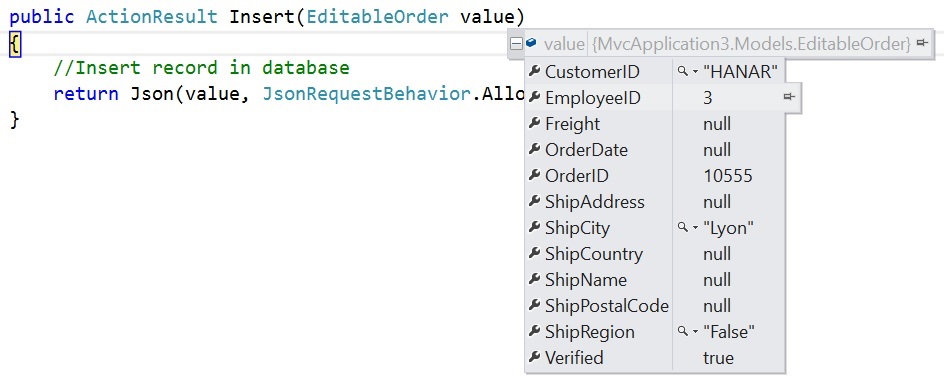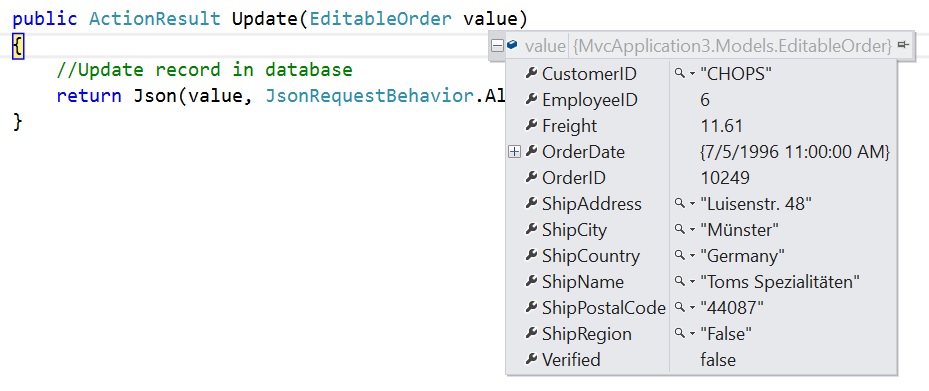Persisting Data in Server in Angular Grid component
Edited data can be persisted in the database using the RESTful web services.
All the CRUD operations in the grid are done through DataManager.
The DataManager has an option to bind all the CRUD related data in server-side.
For your information, the ODataAdaptor persists data in the server as per OData protocol.
In the below section, we have explained how to get the edited data details on the server-side using the
UrlAdaptor.
Using URL adaptor
You can use the UrlAdaptor of DataManager when binding data source from remote data.
In the initial load of grid, data are fetched from remote data and bound to the grid using url property of DataManager.
You can map The CRUD operation in grid can be mapped to server-side Controller actions using the properties
insertUrl, removeUrl, updateUrl, crudUrl and batchUrl.
The following code example describes the above behavior.
import { Component, OnInit } from '@angular/core';
import { EditSettingsModel, ToolbarItems } from '@syncfusion/ej2-angular-grids';
import { DataManager, UrlAdaptor } from '@syncfusion/ej2-data';
@Component({
selector: 'app-root',
template: `<ejs-grid [dataSource]='data' [editSettings]='editSettings' [toolbar]='toolbar' height='273px'>
<e-columns>
<e-column field='OrderID' headerText='Order ID' textAlign='Right'
isPrimaryKey='true' [validationRules]='orderIDRules' width=100></e-column>
<e-column field='CustomerID' headerText='Customer ID' [validationRules]='customerIDRules' width=120></e-column>
<e-column field='Freight' headerText='Freight' textAlign= 'Right'
editType= 'numericedit' width=120 format= 'C2'></e-column>
<e-column field='ShipCountry' headerText='Ship Country' editType= 'dropdownedit' width=150></e-column>
</e-columns>
</ejs-grid>`
})
export class AppComponent implements OnInit {
public data: DataManager;
public editSettings: EditSettingsModel;
public toolbar: ToolbarItems[];
public orderIDRules: object;
public customerIDRules: object;
public dataManager: DataManager = new DataManager({
url: 'Home/UrlDatasource',
updateUrl: 'Home/Update',
insertUrl: 'Home/Insert',
removeUrl: 'Home/Delete',
adaptor: new UrlAdaptor()
});
ngOnInit(): void {
this.data = this.dataManager;
this.editSettings = { allowEditing: true, allowAdding: true, allowDeleting: true, mode: 'Normal' };
this.toolbar = ['Add', 'Edit', 'Delete', 'Update', 'Cancel'];
this.orderIDRules = { required: true };
this.customerIDRules = { required: true, minLength: 3 };
}
}Also, when using the UrlAdaptor, you need to return the data as JSON from the controller action and the JSON object must contain a property as result with dataSource as its value and one more property count with the dataSource total records count as its value.
The following code example describes the above behavior.
public IActionResult UrlDatasource([FromBody]DataManagerRequest dm)
{
IEnumerable DataSource = OrdersDetails.GetAllRecords();
DataOperations operation = new DataOperations();
int count = DataSource.Cast<OrdersDetails>().Count();
if (dm.Skip != 0)
{
DataSource = operation.PerformSkip(DataSource, dm.Skip); //Paging
}
if (dm.Take != 0)
{
DataSource = operation.PerformTake(DataSource, dm.Take);
}
return dm.RequiresCounts ? Json(new { result = DataSource, count = count }) : Json(DataSource);
}Insert record
Using the insertUrl property, you can specify the controller action mapping URL to perform insert operation on the server-side.
The following code example describes the above behavior.
public ActionResult Insert([FromBody]CRUDModel<OrdersDetails> value)
{
OrdersDetails.GetAllRecords().Insert(0, value.value);
return Json(value.value);
}The newly added record details are bound to the value parameter. Please refer to the following screenshot.

Update record
Using the updateUrl property, the controller action mapping URL can be specified to perform save/update operation on the server-side.
The following code example describes the previous behavior.
public ActionResult Update([FromBody]CRUDModel<OrdersDetails> value)
{
var ord = value.value;
OrdersDetails val = OrdersDetails.GetAllRecords().Where(or => or.OrderID == ord.OrderID).FirstOrDefault();
val.OrderID = ord.OrderID;
val.EmployeeID = ord.EmployeeID;
val.CustomerID = ord.CustomerID;
val.Freight = ord.Freight;
val.OrderDate = ord.OrderDate;
val.ShipCity = ord.ShipCity;
return Json(value.value);
}The updated record details are bound to the value parameter. Please refer to the following screenshot.

Delete record
Using the removeUrl property, the controller action mapping URL can be specified to perform delete operation on the server-side.
The following code example describes the previous behavior.
public ActionResult Delete([FromBody]CRUDModel<OrdersDetails> value)
{
OrdersDetails.GetAllRecords().Remove(OrdersDetails.GetAllRecords().Where(or => or.OrderID == int.Parse(value.key.ToString())).FirstOrDefault());
return Json(value);
}The deleted record primary key value is bound to the key parameter. Please refer to the following screenshot.

CRUD URL
Using the crudUrl property, the controller action mapping URL can be specified to perform all the CRUD operation at server-side using a single method instead of specifying separate controller action method for CRUD (insert, update and delete) operations.
The action parameter of crudUrl is used to get the corresponding CRUD action.
The following code example describes the above behavior.
import { Component, OnInit } from '@angular/core';
import { ToolbarItems, EditSettingsModel } from '@syncfusion/ej2-angular-grids';
import { DataManager, UrlAdaptor } from '@syncfusion/ej2-data';
@Component({
selector: 'app-root',
template: `<ejs-grid [dataSource]='data' [editSettings]='editSettings' [toolbar]='toolbar' height='273px'>
<e-columns>
<e-column field='OrderID' headerText='Order ID' textAlign='Right'
isPrimaryKey='true' [validationRules]='orderIDRules' width=100></e-column>
<e-column field='CustomerID' headerText='Customer ID' [validationRules]='customerIDRules' width=120></e-column>
<e-column field='Freight' headerText='Freight' textAlign= 'Right'
editType= 'numericedit' width=120 format= 'C2'></e-column>
<e-column field='ShipCountry' headerText='Ship Country' editType= 'dropdownedit' width=150></e-column>
</e-columns>
</ejs-grid>`
})
export class AppComponent implements OnInit {
public editSettings: EditSettingsModel;
public toolbar: ToolbarItems[];
public orderIDRules: object;
public customerIDRules: object;
public data: DataManager;
ngOnInit(): void {
this.data = new DataManager({
url: 'Home/DataSource',
crudUrl: 'Home/CrudUpdate',
adaptor: new UrlAdaptor()
});
this.editSettings = { allowEditing: true, allowAdding: true, allowDeleting: true, mode: 'Normal' };
this.toolbar = ['Add', 'Edit', 'Delete', 'Update', 'Cancel'];
this.orderIDRules = { required: true };
this.customerIDRules = { required: true, minLength: 3 };
}
}public ActionResult CrudUpdate([FromBody]CRUDModel<OrdersDetails> value, string action)
{
if (value.action == "update")
{
var ord = value.value;
OrdersDetails val = OrdersDetails.GetAllRecords().Where(or => or.OrderID == ord.OrderID).FirstOrDefault();
val.OrderID = ord.OrderID;
val.EmployeeID = ord.EmployeeID;
val.CustomerID = ord.CustomerID;
val.Freight = ord.Freight;
val.OrderDate = ord.OrderDate;
val.ShipCity = ord.ShipCity;
}
else if (value.action == "insert")
{
OrdersDetails.GetAllRecords().Insert(0, value.value);
}
else if (value.action == "remove")
{
OrdersDetails.GetAllRecords().Remove(OrdersDetails.GetAllRecords().Where(or => or.OrderID == int.Parse(value.key.ToString())).FirstOrDefault());
return Json(value);
}
return Json(value.value);
}Please refer to the following screenshot to know about the action parameter.

If you specify insertUrl along with crudUrl, then while adding insertUrl only will be invoked.
Batch URL
The batchUrl property supports only for batch editing mode. You can specify the controller action mapping URL to perform batch operation on the server-side.
The following code example describes the above behavior.
import { Component, OnInit } from '@angular/core';
import { EditSettingsModel, ToolbarItems } from '@syncfusion/ej2-angular-grids';
import { DataManager, UrlAdaptor } from '@syncfusion/ej2-data';
@Component({
selector: 'app-root',
template: `<ejs-grid [dataSource]='data' [editSettings]='editSettings' [toolbar]='toolbar' height='273px'>
<e-columns>
<e-column field='OrderID' headerText='Order ID' textAlign='Right'
isPrimaryKey='true' [validationRules]='orderIDRules' width=100></e-column>
<e-column field='CustomerID' headerText='Customer ID' [validationRules]='customerIDRules' width=120></e-column>
<e-column field='Freight' headerText='Freight' textAlign= 'Right'
editType= 'numericedit' width=120 format= 'C2'></e-column>
<e-column field='ShipCountry' headerText='Ship Country' editType= 'dropdownedit' width=150></e-column>
</e-columns>
</ejs-grid>`
})
export class AppComponent implements OnInit {
public editSettings: EditSettingsModel;
public toolbar: ToolbarItems[];
public orderIDRules: object;
public customerIDRules: object;
public data: DataManager;
ngOnInit(): void {
this.data = new DataManager({
url: 'Home/DataSource',
batchUrl: 'Home/BatchUpdate',
adaptor: new UrlAdaptor()
});
this.editSettings = { allowEditing: true, allowAdding: true, allowDeleting: true, mode: 'Batch' };
this.toolbar = ['Add', 'Edit', 'Delete', 'Update', 'Cancel'];
this.orderIDRules = { required: true };
this.customerIDRules = { required: true, minLength: 3 };
}
}public IActionResult BatchUpdate([FromBody]CRUDModel batchmodel)
{
if (batchmodel.Changed != null)
{
for (var i = 0; i < batchmodel.Changed.Count(); i++)
{
var ord = batchmodel.Changed[i];
Orders val = order.Where(or => or.OrderID == ord.OrderID).FirstOrDefault();
val.OrderID = ord.OrderID;
val.EmployeeID = ord.EmployeeID;
val.CustomerID = ord.CustomerID;
val.ShipCity = ord.ShipCity;
}
}
if (batchmodel.Deleted != null)
{
for (var i = 0; i < batchmodel.Deleted.Count(); i++)
{
order.Remove(order.Where(or => or.OrderID == batchmodel.Deleted[i].OrderID).FirstOrDefault());
}
}
if (batchmodel.Added != null)
{
for (var i = 0; i < batchmodel.Added.Count(); i++)
{
order.Insert(0, batchmodel.Added[i]);
}
}
var data = order.ToList();
return Json(data);
}
